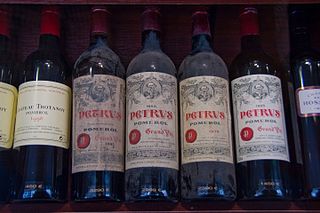
Château Pétrus is a Bordeaux, France, wine estate located in the Pomerol appellation near its eastern border to Saint-Émilion. A small estate of just 11.4 hectares, it produces a red wine entirely from Merlot grapes, and produces no second wine. The estate belongs to Jean-François Moueix and his children.
Michel Rolland is a Bordeaux-based oenologist, with hundreds of clients across 13 countries and influencing wine style around the world. "It is his consultancies outside France that have set him apart from all but a handful of his countrymen." It is frequently addressed that his signature style, which he helps wineries achieve, is fruit-heavy and oak-influenced, a preference shared by influential critic Robert Parker.

Château Grand Corbin-Despagne is a wine from the Saint-Émilion appellation of the Bordeaux wine region of France, ranked a Grand Cru in the Classification of Saint-Émilion wine. The winery is located in the northern part of the Saint-Émilion commune, close to the border of Pomerol.
Château Canon, originally Clos St-Martin, is a Bordeaux wine from the Saint-Émilion appellation, ranked among the Premiers grands crus classés B in the Classification of Saint-Émilion wine. The winery is located just southwest of the old town of Saint-Émilion within the commune of the same name, closely neighbouring the estates such as Château Magdelaine, Château La Gaffelière and Château Ausone and has since the early 20th century been considered one of the top Saint-Émilions.
Château Bélair-Monange, named until 2007 Château Belair, is a Bordeaux vineyard from the appellation Saint-Émilion Grand Cru, ranked Premier grand cru classé B in the Classification of Saint-Émilion wine. The winery is located in the Right Bank of France’s Bordeaux wine region in the commune of Saint-Émilion, in the department Gironde. The estate was considered a leading producer of Saint-Émilion until the 20th century.
Château Beau-Séjour Bécot, formerly Château Beauséjour-Dr-Fagouet, is a Bordeaux wine from the appellation Saint-Émilion, ranked Premier grand cru classé B in the Classification of Saint-Émilion wine. The winery is located in the Right Bank of France’s Bordeaux wine region in the commune of Saint-Émilion, in the department Gironde.
Château Beauséjour, formerly fully titled Château Beauséjour-Duffau-Lagarrosse, is a Bordeaux wine from the appellation Saint-Émilion, ranked Premier grand cru classé B in the Classification of Saint-Émilion wine. The winery is located in the Right Bank of France’s Bordeaux wine region in the commune of Saint-Émilion, in the department Gironde.
Clos Fourtet, previously Château Clos Fourtet and archaically Camfourtet, is a Bordeaux wine from the appellation Saint-Émilion, ranked Premier grand cru classé B in the Classification of Saint-Émilion wine. The Clos Fourtet winery is located in the Right Bank of France's Bordeaux wine region in the commune of Saint-Émilion, in the department Gironde.
Château Fonroque is a Bordeaux wine from the appellation Saint-Émilion, ranked Grand cru classé in the Classification of Saint-Émilion wine. The winery is located in the Right Bank of France’s Bordeaux wine region in the commune of Saint-Émilion, in the department Gironde.
Château Quinault is a winery from the appellation Saint-Émilion within the city of Libourne, producing Quinault L'Enclos, a Bordeaux wine counted among the Bordeaux Right Bank "supercuvées" or "vins de garage". The estate also produces a second wine, Lafleur de Quinault, and a special cuvée called L'Absolut de Quinault.
Château Monbousquet is a Bordeaux wine which has the appellation Saint-Émilion, ranked Grand cru classé in the Classification of Saint-Émilion wine. The winery is located in the Right Bank of France’s Bordeaux wine region in the commune of Saint-Sulpice-de-Faleyrens, in the department Gironde.
Établissements Jean-Pierre Moueix, or JP Moueix, is a Bordeaux négociant house founded by Jean-Pierre Moueix in 1937, situated on the Quai du Priourat in Libourne, in the Bordeaux wine region of France. While dealing in wholesale distribution of numerous Right Bank wines, the company also acts as a bulk grape merchant, operates exclusive distribution for select châteaux, and manages its own portfolio of Pomerol and Saint-Émilion estates. The company has 120 employees.
Château Hosanna, formerly Château Certan-Giraud, is a Bordeaux wine from the appellation Pomerol. The winery is located on the Right Bank of the Bordeaux wine region, in the commune of Pomerol in the department Gironde. As all wine produced in this appellation, Château Hosanna is unclassified, but Certan-Giraud has historically been estimated among the great crus of the region.
Château la Tour du Pin Figeac may refer to two Bordeaux wine estates in Saint-Émilion:

Pomerol is a French wine-growing commune and Appellation d'origine contrôlée (AOC) within the Libournais in Bordeaux. The wine produced here is predominately from Merlot with Cabernet Franc playing a supporting role. Unlike most other Bordeaux communes, there is no real village of Pomerol, although there is a church. The houses are set among the vineyards.
Thierry Manoncourt was a French winery owner of the Grand Cru estate Château Figeac in Bordeaux, and for many decades a major figure of Bordeaux and the Saint-Émilion appellation.










